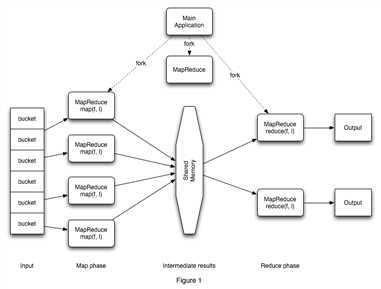标签:blog http os java io strong for ar 文件
背景:
在大数据领域, 由于各方面的原因. 有时需要自己来生成测试数据集, 由于测试数据集较大, 因此采用Map/Reduce的方式去生成. 在这小编(mumuxinfei)结合自身的一些实战经历, 具体阐述下生成测试数据集的Map/Reduce程序该如何写?
场景构造:
假设某移动电信行业的某具体业务, 其记录了通话信息(包括拨打方/接听方/通话时间点/基站 等要素). 产商是不可能提供真实的用户数据用于测试的, 但提供了基本的数据规格. 具体针对该业务场景, 我们简单规划如下:
num1 varchar(13) -- 手机号码(130 xxxx xxxx ~ 139 xxxx xxxx) num2 varchar(13) -- 手机号码(130 xxxx xxxx ~ 139 xxxx xxxx) lac varchar(16) -- 基站信息 timestamp varchar(128) -- yyyyMMdd hh:mm:ss格式
评注: 数据的分布在时间纬度上, 相对还是如意编造, 在其他纬度上, 要模拟真实的用户行为数据, 还是有一定的难度的.
Map/Reduce理论基础:
1). Map/Reduce的原理架构图

评注: Map/Reduce的运行和流程基本如图所示(来源于网络), 这边我们对原理不再详细阐述.
2). Map/Reduce的类体系架构
详见如下关于Map/reduce的类系统架构的基础文章
方案分析:
在回顾完Map/Reduce的基础架构后, 针对数据生成, 我们提供如下的两种方案.
1). 传统的Map/Reduce的数据生成方案
2). 只有Map/没有Reduce的数据生成方案.
这两者有何区别呢? 如何在Job中控制和设置?
1). Map阶段的产出结果经过sort/shuffle到reduce的, 由此Reduce阶段后的数据是有一定的顺序性的. 而止于Map阶段的数据是呈现一定随机性. 聪明的你是否猜着了? bingo, 如果生成的数据需要一定的排序组合, 则需要传统方案. 而如果生成的数据随机即可, 则采用2方案就好.
2). Job的任务配置, 只需要配置numReduceTasks即可
job.setNumReduceTasks(0);
评注: 是不是很简单, 不好意思让你大跌眼镜了....^_^!
综合实际的案例分析, 我们的测试数据是随机分布的, 由此我们选用方案2.
解决方案:
我们选定的方案大致如下:
通过Map阶段来生成测试数据, 自定义InputFormat规则.
我们的目标是, 运行MapReduce程序, 生成CSV格式的数据文件, 内容组织如下:
#num1,num2,lac,timestamp 1380001234,13800005678,1,2014-08-27 10:30:00 1380002058,13800005678,1,2014-08-28 11:30:00
1). 自定义InputForamt, 以及内部的InputSplit和RecordReader
MyInputSplit的类定义如下:
// *) 继承与InputSplit, 通过实现Writable接口
public static class MyInputSplit
extends InputSplit implements Writable {
private int number;
// 需要一个无参构造函数
public MyInputSplit() {
}
public MyInputSplit(int number) {
this.number = number;
}
@Override
public long getLength()
throws IOException, InterruptedException {
return 0;
}
@Override
public String[] getLocations()
throws IOException, InterruptedException {
return new String[]{};
}
public int getNumber() {
return number;
}
// *) 反序列化
public void readFields(DataInput in)
throws IOException {
number = WritableUtils.readVInt(in);
}
// *) 序列化
public void write(DataOutput out)
throws IOException {
WritableUtils.writeVInt(out, number);
}
}
评注: MyInputSplit必须实现Writable接口, 因为InputSplit在map/reduce过程中需要序列化/反序列化, 同时InputSplit的实现类需要提供一个无参构造函数, 因为需要反射来实例化该对象. 请不要问我为何知道的这么说, 我只想说: "请叫我活雷锋!".
MyRecordReader的定义如下所示:
public static class MyRecordReader
extends RecordReader<NullWritable, Text> {
private int current = 0;
private int number = 0;
private Text valueText = new Text();
// *) 初始化工作
@Override
public void initialize(InputSplit split, TaskAttemptContext context)
throws IOException, InterruptedException {
this.number = ((MyInputSplit)split).getNumber();
}
@Override
public boolean nextKeyValue() throws IOException, InterruptedException {
if ( current++ < number ) {
valueText.set(DataGeneratorUtility.genetateData());
return true;
}
return false;
}
@Override
public NullWritable getCurrentKey() throws IOException,
InterruptedException {
return NullWritable.get();
}
@Override
public Text getCurrentValue() throws IOException,
InterruptedException {
return valueText;
}
// *) 汇报进度
@Override
public float getProgress() throws IOException, InterruptedException {
return current * 1.0f / number;
}
@Override
public void close() throws IOException {
}
}
评注: MyRecordReader相对就简单了, 由于map默认是单线程生成, 因此采用带状态的函数nextKeyValue(), getCurrentKey(), getCurrentValue(). 不合理阿, 老师!!!
最后来展示下MyInputFormat的实现, 其整合了之上的InputSplit和RecordReader.
public class MyInputFormat
extends InputFormat<NullWritable, Text> {
@Override
public List<InputSplit> getSplits(JobContext context)
throws IOException, InterruptedException {
int splitNumber = Integer.parseInt(
context.getConfiguration().get("data.split_number"));
int dataNumber = Integer.parseInt(
context.getConfiguration().get("data.data_number"));
List<InputSplit> results = new ArrayList<InputSplit>();
for ( int i = 0; i < splitNumber; i++ ) {
results.add(new MyInputSplit(dataNumber));
}
return results;
}
@Override
public RecordReader<NullWritable, Text> createRecordReader(
InputSplit split, TaskAttemptContext context)
throws IOException, InterruptedException {
return new MyRecordReader();
}
}
评注: MyInputFormat的实现, 就是获取分片信息, 以及提供对应的RecordReader, 对于Map/Reduce程序而言, 起到一个桥梁的作用.
2). Map的定义处理
public class MyMap extends Mapper<NullWritable, Text, NullWritable, Text> {
@Override
protected void map(NullWritable key, Text value, Context context)
throws IOException, InterruptedException {
context.write(key, value);
}
}
评注: MyMap的工作非常的简单, 就是单纯的write key/value对
3). Job配置选项
public class MyJob extends Configured implements Tool {
@Override
public int run(String[] args) throws Exception {
Job job = Job.getInstance(getConf());
Path outputDir = new Path(args[0]);
FileOutputFormat.setOutputPath(job, outputDir);
job.setJobName("MyJob");
job.setJarByClass(MyJob.class);
job.setMapperClass(MyMap.class);
// *) 设置reducer task 为0
job.setNumReduceTasks(0);
job.setOutputKeyClass(NullWritable.class);
job.setOutputValueClass(Text.class);
// *) 设置MyInputFormat
job.setInputFormatClass(MyInputFormat.class);
// *) 传入相关参数
job.getConfiguration().set("data.split_number", args[1]);
job.getConfiguration().set("data.data_number", args[2]);
return job.waitForCompletion(true) ? 0 : 1;
}
public static void main(String[] args) throws Exception {
int res = ToolRunner.run(new Configuration(), new MyJob(), args);
System.exit(res);
}
}
评注: 这边省略了部分参数的校验. 大致要点就是设置 NumReduceTasks(0), 然后设置InputFormatClass类MyInputFormat. Ok Let it go!!!
测试:
编译成jar之后, 在mapreduce跑
结果: mapreduce运行成功, 总共2个map, 每个map生成10行记录
验证map的文件个数
评注: part-m-00000, part-m-00001表明是map阶段生成的输出文件
对文件内容进行验证: 
评注: 数据结果符合预期
总结:
这边讲述了利用map/reduce生成测试集的一个流程, 同时也是写给自己, 希望自己对mapreduced的内部机制,有个更清晰的理解.
标签:blog http os java io strong for ar 文件
原文地址:http://www.cnblogs.com/mumuxinfei/p/3938108.html